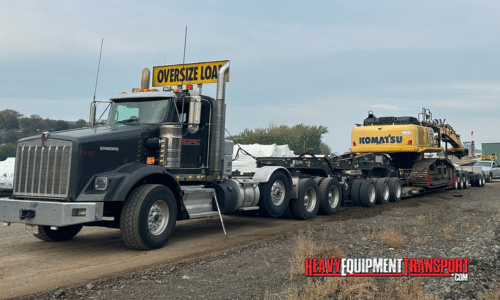The Challenges and Solutions of Transporting Oversize Loads

William Thomas / January 2021
Oversized load transportation is a challenging undertaking that requires careful planning and execution. These cargoes face special difficulties due to their enormous size and weight, including logistical difficulties and legal restrictions that may have a substantial impact on the effectiveness of transportation. To ensure a delivery that is secure, on schedule, and reasonably priced, it is essential to comprehend these obstacles. This blog offers a thorough examination of these issues, illuminating the solutions that can make these onerous chores approachable.
Brief Definition of Oversized/Overweight Loads

“Class aptent taciti sociosqu ad litora per conubia nostra, per inceptos himenaeos .Aenean non turpis vitae ligula tristique sagitt isras varius erat pulvinar eros pretium”
Oversized or overweight loads are those that are heavier or bigger than the permitted legal limitations for road transportation. A cargo is considered as “oversized” if:
• Its wider than 8.6 feet
• Height than 13.6 feet
• Longer over 48 to 53 feet
The maximum weight varies by location depending on infrastructure, although a load is typically considered “overweight” if it weighs more than 80,000 pounds. These loads frequently consist of massive cars, industrial boilers, wind turbine blades, cranes and excavators, heavy machinery, and modular homes.

Transport Your Oversize Load Today
Heavy Equipment Transport is always available for a quote. Fill out the form or give us a call now! (888) 730-2951
Infrastructure Limitations
Transporting big weights is significantly hampered by infrastructure features like congested tunnels, low bridges, and narrow highways. Heavy freight must be maneuvered through these confines carefully to avoid delays, damage, and even accidents. Consequently, thorough route planning is essential. It entails anticipating probable roadblocks and locating detours or workarounds. By doing this, it not only assures the load’s safety and integrity but also helps the transport process run more smoothly overall by preventing unforeseen obstacles and expensive setbacks.

Legal and Regulatory Requirements
Obtaining special licenses is always required when transporting big cargoes because they confirm the transit’s legality and safety. These licenses contain special requirements like:
• Travel times
• Escorted cars
• Signage
States’ or nations’ regulatory requirements vary greatly, complicating the process of obtaining permits. Therefore, it is essential to abide by the particular rules of each jurisdiction to prevent legal ramifications and guarantee a smooth transit process. In summary, a key component of transporting big loads is understanding and adhering to these varied regulatory regimes.
Equipment and Handling Challenges
In order to handle huge loads, you need:
• Specialized machinery like trailers and cranes that can handle large dimensions and heavy weights. These devices are necessary to protect the cargo’s integrity and guarantee safe transit.
• The availability of knowledgeable experts who can handle such equipment with ease. Their knowledge and experience can greatly lower the possibility of damage occurring during transit, ensuring the load is safe and undamaged.
In essence, the successful delivery of big freight relies on a mix of specialized machinery and knowledgeable operators.
Costs of Oversize Load Transport
A number of contributing factors can cause the cost of moving big cargoes to vary significantly. They include:
• fuel prices which fluctuate dependent on market conditions and can considerably effect the entire expense,
• Tolls also raise the price because it is common for big cargo to be transported across toll bridges and roads.
• Employing escort services, which are frequently required for safety reasons, may increase expenditures. These escorts direct the transport vehicles, assisting in the prevention of accidents and guaranteeing adherence to traffic laws. Therefore, when planning a budget for the transport of big loads, these factors must be taken into account.
Safety Concerns
Oversized cargo transportation involves significant dangers. A lack of visibility may jeopardize road safety, improper handling may result in equipment failure, and incorrectly estimated dimensions may result in infrastructure damage. Precise planning and route selection are essential to reducing these hazards. This involves:
• A detailed evaluation of the infrastructure’s size and the state of the roads.
• Hazards can be reduced by deploying escort vehicles and qualified handling personnel for safe maneuvering.
• The safety of the cargo, the crew, and the general public is also supported by regular maintenance inspections of the transportation equipment and adherence to transportation rules.
Role of Technology
Technology is essential to the transportation of big loads.
• Accurate route planning is made possible by modern GPS systems, which help to avoid highways unfit for carrying huge loads and guarantee that the safest, most direct route is adopted.
• Continuous monitoring of the cargo is possible thanks to real-time tracking technology, increasing accountability and transparency.
All parties involved can instantly exchange information thanks to communication technology, which facilitate flawless collaboration. Additionally, process efficiency has increased thanks to innovations like automated load-detection systems and IoT-integrated transport management, which have streamlined the process and reduced human error. The transportation of enormous items has undergone a genuine revolution because to these technological developments.
Remedy and Ideal Techniques
Careful planning, using technology, and working with transportation authorities are some methods for overcoming obstacles in the transfer of big cargo.
A prime example is the 2012 movement of the Space Shuttle Endeavour through Los Angeles, which was made possible thanks to meticulous preparation, close coordination with local authorities, and the deployment of self-propelled modular transporters (SPMTs). These instances highlight the value of thorough systems for handling the delivery of big loads.
Significant logistical, safety, and regulatory hurdles must be overcome when transporting big items. These challenges may be overcame, though, with careful preparation, efficient collaboration, and the use of the right resources. Modern technology use makes a big contribution to improving productivity and lowering human error. Successful case studies that emphasize the significance of these tactics include the transfer of the 400-ton generator and the Space Shuttle Endeavour. Adopting these best practices will be essential for profitable and effective big cargo transit as the transportation sector continues to develop.

William Thomas
Heavy Transport Specialist
Being able to lead a team of such talented logistics agents has been a wonderful experience over the past ten years. If you would like to know anything more about the heavy equipment transport services we offer, don't hesitate to give us a call!